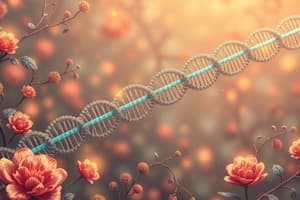Podcast
Questions and Answers
Which consensus sequence is bound by the TFIID complex?
Which consensus sequence is bound by the TFIID complex?
- CAAT box
- GC box
- TATA box (correct)
- Enhancer
In which direction does RNA polymerase read DNA?
In which direction does RNA polymerase read DNA?
- 3' to 5' (correct)
- Bidirectional
- It reads DNA in a non-directional manner
- 5' to 3'
What is the function of the TATA box?
What is the function of the TATA box?
- It determines the starting point for RNA synthesis (correct)
- It codes for a specific amino acid
- It is involved in splicing of introns
- It signals the site of termination for transcription
Why do different cells express different genes?
Why do different cells express different genes?
What is the difference between exons and introns?
What is the difference between exons and introns?
Which component of the promoter is considered distal?
Which component of the promoter is considered distal?
What is the role of enhancers in gene expression?
What is the role of enhancers in gene expression?
What is the name of the process that synthesizes RNA from DNA?
What is the name of the process that synthesizes RNA from DNA?
What is the function of transcription factors?
What is the function of transcription factors?
What is the difference between the template strand and the nontemplate strand?
What is the difference between the template strand and the nontemplate strand?
Flashcards
Gene Components
Gene Components
A gene consists of coding exons, noncoding introns, and noncoding sequences.
Gene Expression
Gene Expression
The process by which specific genes are activated or silenced in cells.
Transcription
Transcription
The process of synthesizing RNA from a DNA template.
RNA Polymerase
RNA Polymerase
Signup and view all the flashcards
Consensus Sequence
Consensus Sequence
Signup and view all the flashcards
Promoters
Promoters
Signup and view all the flashcards
Basal Promoters
Basal Promoters
Signup and view all the flashcards
Enhancers
Enhancers
Signup and view all the flashcards
TFIID
TFIID
Signup and view all the flashcards
Transcription Direction
Transcription Direction
Signup and view all the flashcards
Study Notes
Learning Objectives
- Identify the components of a gene
- Describe the transcription process in terms of genetic information flow
- Identify transcription proteins and consensus sequences, along with their functions
- Give examples of current RNA synthesis inhibitors
Gene Expression
- A chromosome contains hundreds or thousands of genes, but only a portion is active at any given time
- Different cells express distinct gene selections depending on their roles within an organism
- Gene expression varies throughout developmental stages
Gene Structure
- Eukaryotic genes are made up of coding exons, noncoding introns, and noncoding consensus sequences
- Noncoding regions preceding the first exon are upstream sequences; those after the last exon are downstream sequences
Transcription
-
RNA is copied from a DNA strand.
-
Two strands exist: template and non-template (coding)
-
RNA synthesis proceeds from 5' to 3'
-
Only one strand is transcribed
-
The process is unidirectional
-
RNA polymerase synthesizes RNA from DNA within the nucleus
-
RNA polymerase reads DNA from 3' to 5' and creates a complementary RNA sequence
Consensus Sequence
- DNA recognition sites often bound by proteins (transcription factors) and other regulatory proteins
- Promoters are DNA sequences determining the start of RNA synthesis
Basal Promoters
- Consist of proximal (TATA box) and distal (CAAT and GC boxes) components
Enhancers and Response Elements
- Regulate gene expression; can enhance or repress expression in response to signals (like hormones and chemicals)
- Typically located upstream or downstream of a transcription start site
TFIID (TBP + Associated Factors)
- Binds to the TATA box in the minor DNA groove, causing a bend in the DNA helix.
- TFIIF has DNA helicase activity, helping unwind DNA near the transcription start site
- Allows RNA Polymerase to access the DNA
RNA Synthesis Inhibitors
- Alpha-amanitin (α-AMA): toxin found in Amanita phalloides mushrooms; inhibits RNA polymerase II, leading to protein deficiency and cell death
- Actinomycin D: chemotherapeutic drug treating various cancers (e.g., Wilms tumor); interferes with transcription by binding to DNA during initiation, preventing RNA chain elongation
- Rifampin: antibiotic inhibiting bacterial RNA synthesis by binding to bacterial RNA polymerase. This prevents the initiation by uninhibited enzymes.
Retroviruses (Human Immunodeficiency Virus - HIV)
- Retroviruses have an RNA genome
- Reverse transcriptase copies the RNA into cDNA
- The cDNA is integrated into the host cell's genome for replication within the host cell.
Studying That Suits You
Use AI to generate personalized quizzes and flashcards to suit your learning preferences.




